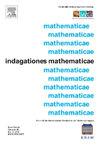全形离散级数的简化方法
IF 0.8
4区 数学
Q3 MATHEMATICS
引用次数: 0
摘要
这篇文章阐述了赫米蒂型半简单李群及其称为全形离散级数的单元式表示。文章描述了与这些群相关的对称空间作为有界对称域的实现。有关表示是通过全形归纳法定义的,并在域上的向量全形函数空间上实现。一个关键问题是归纳过程是否会产生一个非零空间。哈里什-钱德拉条件回答了这个问题,并给出了完整的证明。本文章由计算机程序翻译,如有差异,请以英文原文为准。
A simplified approach to the holomorphic discrete series
Expository article on semisimple Lie groups of Hermitian type and their unitary representations known as the holomorphic discrete series. The realization of the symmetric spaces associated to the groups as bounded symmetric domains is described. The representations in question are defined by holomorphic induction and realized on spaces of vector-valued holomorphic functions on the domain. A key question is whether the induction process yields a non-zero space. It is answered by Harish-Chandra’s condition, for which a complete proof is given.
求助全文
通过发布文献求助,成功后即可免费获取论文全文。
去求助
来源期刊
CiteScore
1.20
自引率
16.70%
发文量
74
审稿时长
79 days
期刊介绍:
Indagationes Mathematicae is a peer-reviewed international journal for the Mathematical Sciences of the Royal Dutch Mathematical Society. The journal aims at the publication of original mathematical research papers of high quality and of interest to a large segment of the mathematics community. The journal also welcomes the submission of review papers of high quality.

 求助内容:
求助内容: 应助结果提醒方式:
应助结果提醒方式:


